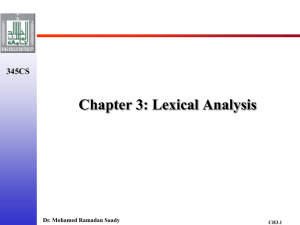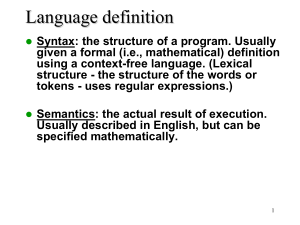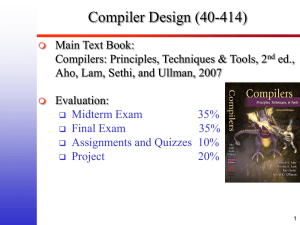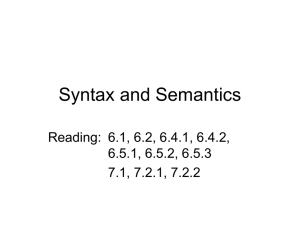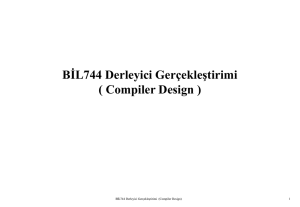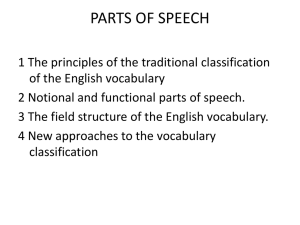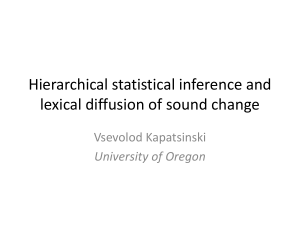lecture6
advertisement
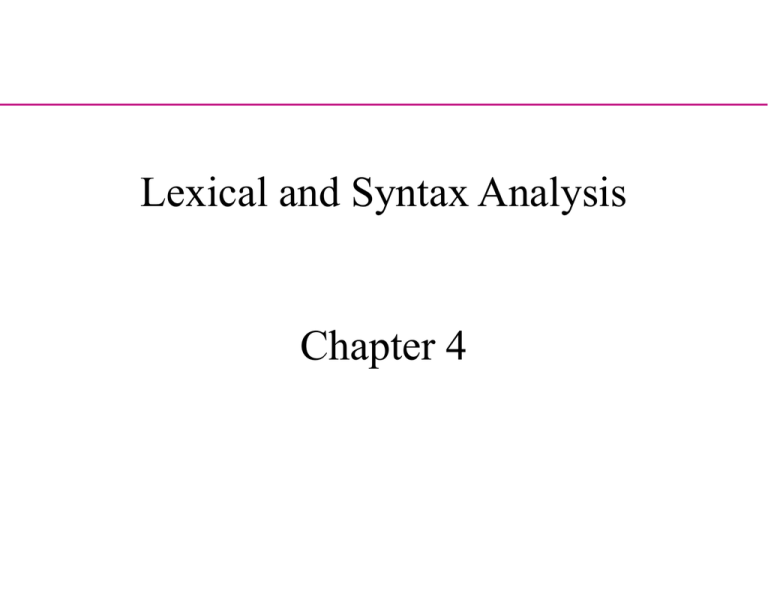
Lexical and Syntax Analysis
Chapter 4
Compilation
•
•
Translating from high-level language to machine
code is organized into several phases or passes.
In the early days passes communicated through
files, but this is no longer necessary.
Language Specification
• We must first describe the language in question
by giving its specification.
• Syntax:
• Defines symbols (vocabulary)
• Defines programs (sentences)
• Semantics:
• Gives meaning to sentences.
• The formal specifications are often the input to
tools that build translators automatically.
Compiler passes
String of characters
Lexical
Analyzer
String of tokens
Parser
Abstract syntax tree
Abstract syntax tree
Semantic
Analyzer
Abstract syntax tree
Source-to-source
optimizer
Abstract syntax tree
Translator
Medium-level intermediate code
Low-level intermediate code
Optimizer
Optimizer
Medium-level intermediate code
Low-level intermediate code
Low-level intermediate code
Final
Assembly
Executable/object code
Translator
Compiler passes
source program
front end
Lexical scanner
Parser
semantic analyzer
symbol table
manager
error handler
Translator
Optimizer
Final assembly
target program
back end
Lexical analyzer
•
Also called a scanner or tokenizer
Converts stream of characters into a stream of
tokens
•
Tokens are:
•
•
•
•
•
Keywords such as for, while, and class.
Special characters such as +, -, (, and <
Variable name occurrences
Constant occurrences such as 1, 0, true.
Comparison with Lexical Analysis
Phase
Input
Output
Lexer
Sequence of
characters
Sequence of
tokens
Parser
Sequence of
tokens
Parse tree
Lexical analyzer
•
•
The lexical analyzer is usually a subroutine
of the parser.
Each token is a single entity. A numerical
code is usually assigned to each type of
token.
Lexical analyzer
• Lexical analyzers perform:
• Line reconstruction
• delete comments
• delete white spaces
• perform text substitution
• Lexical translation: translation of lexemes ->
tokens
• Often additional information is affiliated with a
token.
Parser
•
•
•
Performs syntax analysis
Imposes syntactic structure on a sentence.
Parse trees are used to expose the structure.
•
•
•
These trees are often not explicitly built
Simpler representations of them are often used
Parsers, accepts a string of tokens and builds a
parse tree representing the program
Parser
•
The collection of all the programs in a given
language is usually specified using a list of rules
known as a context free grammar.
Parser
A grammar has four components:
A set of tokens known as terminal symbols
A set of variables or non-terminals
A set of productions where each production
consists of a non-terminal, an arrow, and a
sequence of tokens and/or non-terminals
A designation of one of the nonterminals as the
start symbol.
Symbol Table Management
• The symbol table is a data structure used by
all phases of the compiler to keep track of
user defined symbols and keywords.
• During early phases (lexical and syntax
analysis) symbols are discovered and put
into the symbol table
• During later phases symbols are looked up
to validate their usage.
Symbol Table Management
• Typical symbol table activities:
•
•
•
•
•
•
add a new name
add information for a name
access information for a name
determine if a name is present in the table
remove a name
revert to a previous usage for a name (close a
scope).
Symbol Table Management
• Many possible Implementations:
•
•
•
•
linear list
sorted list
hash table
tree structure
Symbol Table Management
• Typical information fields:
•
•
•
•
•
•
•
print value
kind (e.g. reserved, typeid, varid, funcid, etc.)
block number/level number
type
initial value
base address
etc.
Abstract Syntax Tree
•
•
•
The parse tree is used to recognize the components of the
program and to check that the syntax is correct.
As the parser applies productions, it usually generates the
component of a simpler tree (known as Abstract Syntax
Tree).
The meaning of the component is derived out of the way
the statement is organized in a subtree.
Semantic Analyzer
•
The semantic analyzer completes the symbol table with
information on the characteristics of each identifier.
•
The symbol table is usually initialized during parsing.
•
One entry is created for each identifier and constant.
•
•
Scope is taken into account. Two different variables with
the same name will have different entries in the symbol
table.
The semantic analyzer completes the table using
information from declarations.
Semantic Analyzer
•
The semantic analyzer does
•
•
•
•
Type checking
Flow of control checks
Uniqueness checks (identifiers, case labels, etc.)
One objective is to identify semantic errors
statically. For example:
•
•
•
•
Undeclared identifiers
Unreachable statements
Identifiers used in the wrong context.
Methods called with the wrong number of
parameters or with parameters of the wrong type.
Semantic Analyzer
•
Some semantic errors have to be detected at run
time. The reason is that the information may not
be available at compile time.
•
•
•
Array subscript is out of bonds.
Variables are not initialized.
Divide by zero.
Error Management
• Errors can occur at all phases in the compiler
• Invalid input characters, syntax errors, semantic
errors, etc.
• Good compilers will attempt to recover from
errors and continue.
Translator
•
•
The lexical scanner, parser, and semantic analyzer are
collectively known as the front end of the compiler.
The second part, or back end starts by generating low
level code from the (possibly optimized) AST.
Translator
• Rather than generate code for a specific
architecture, most compilers generate
intermediate language
• Three address code is popular.
• Really a flattened tree representation.
• Simple.
• Flexible (captures the essence of many target
architectures).
• Can be interpreted.
Translator
• One way of performing intermediate code
generation:
• Attach meaning to each node of the AST.
• The meaning of the sentence = the “meaning”
attached to the root of the tree.
XIL
•
•
An example of Medium level intermediate
language is XIL. XIL is used by IBM to compile
FORTRAN, C, C++, and Pascal for RS/6000.
Compilers for Fortran 90 and C++ have been
developed using XIL for other machines such as
Intel 386, Sparc, and S/370.
Optimizers
• Intermediate code is examined and improved.
• Can be simple:
• changing “a:=a+1” to “increment a”
• changing “3*5” to “15”
• Can be complicated:
• reorganizing data and data accesses for cache
efficiency
• Optimization can improve running time by orders of
magnitude, often also decreasing program size.
Code Generation
• Generation of “real executable code” for a
particular target machine.
• It is completed by the Final Assembly phase
• Final output can either be
• assembly language for the target machine
• object code ready for linking
• The “target machine” can be a virtual machine
(such as the Java Virtual Machine, JVM), and
the “real executable code” is “virtual code”
(such as Java Bytecode).
Compiler Overview
Source Program
IF (a<b) THEN c=1*d;
Lexical Analyzer
IF
(
Token Sequence
ID
“b”
<
THEN
ID
“c”
CONST
=
*
“1”
a
cond_expr
Syntax Analyzer
Syntax Tree
ID
“a”
<
b
IF_stmt
c
list
assign_stmt
Semantic Analyzer
3-Address Code
GE a, b, L1
MUlT 1, d, c
L1:
Optimized 3-Addr. Code
Assembly Code
1
rhs
*
Code Optimizer
Code Generation
lhs
d
GE a, b, L1
MOV d, c
L1:
loadi R1,a
cmpi R1,b
jge L1
loadi R1,d
storei R1,c
L1:
ID
“d”
Lexical Analysis
What is Lexical Analysis?
- The lexical analyzer deals with small-scale language
constructs, such as names and numeric literals. The syntax
analyzer deals with the large-scale constructs, such as
expressions, statements, and program units.
-
The syntax analysis portion consists of two parts:
1. A low-level part called a lexical analyzer (essentially a
pattern matcher).
2. A high-level part called a syntax analyzer, or parser.
The lexical analyzer collects characters into logical
groupings and assigns internal codes to the groupings
according to their structure.
Lexical Analyzer in Perspective
source
program
lexical
analyzer
token
parser
get next
token
symbol
table
Lexical Analyzer in Perspective
• LEXICAL ANALYZER
• Scan Input
• PARSER
• Remove white space, …
•
Perform Syntax Analysis
• Identify Tokens
•
Actions Dictated by Token
Order
• Create Symbol Table
•
Update Symbol Table
Entries
•
Create Abstract Rep. of
Source
•
Generate Errors
• Insert Tokens into AST
• Generate Errors
• Send Tokens to Parser
Lexical analyzers extract lexemes from a given input
string and produce the corresponding tokens.
Sum = oldsum – value /100;
Token
Lexeme
IDENT
ASSIGN_OP
IDENT
SUBTRACT_OP
IDENT
DIVISION_OP
INT_LIT
SEMICOLON
sum
=
oldsum
value
/
100
;
Basic Terminology
• What are Major Terms for Lexical Analysis?
• TOKEN
• A classification for a common set of strings
• Examples Include <Identifier>, <number>, etc.
• PATTERN
• The rules which characterize the set of strings
for a token
• LEXEME
• Actual sequence of characters that matches
pattern and is classified by a token
• Identifiers: x, count, name, etc…
Basic Terminology
Token
Sample Lexemes
Informal Description of Pattern
const
const
const
if
if
if
relation
<, <=, =, < >, >, >=
< or <= or = or < > or >= or >
id
pi, count, D2
letter followed by letters and digits
num
3.1416, 0, 6.02E23
any numeric constant
literal
“core dumped”
any characters between “ and “ except “
Classifies
Pattern
Actual values are critical. Info is :
1. Stored in symbol table
2. Returned to parser
Token Definitions
Suppose: S ts the string banana
Prefix : ban, banana
Suffix : ana, banana
Substring : nan, ban, ana,
banana
Subsequence: bnan, nn
Token Definitions
letter A | B | C | … | Z | a | b | … | z
digit 0 | 1 | 2 | … | 9
id letter ( letter | digit )*
Shorthand Notation:
“+” : one or more
r* = r+ | & r+ = r r*
“?” : zero or one
r?=r |
[range] : set range of characters (replaces “|” )
[A-Z] = A | B | C | … | Z
id [A-Za-z][A-Za-z0-9]*
Token Recognition
Assume Following Tokens:
if, then, else, re-loop, id, num
What language construct are they used for ?
Given Tokens, What are Patterns ?
Grammar:
if
if
stmt |if expr then stmt
then then
|if expr then stmt else stmt
|
else else
expr term re-loop term | term
Re-loop < | <= | > | >= | = | <>
term id | num
id
letter ( letter | digit )*
num digit + (. digit + ) ? ( E(+ | -) ? digit + ) ?
What does this represent ?
What Else Does Lexical Analyzer Do?
Scan away b, nl, tabs
Can we Define Tokens For These?
blank
tab
newline
delim
ws
b
^T
^M
blank | tab | newline
delim +
Symbol Tables
Regular
Expression
ws
if
then
else
id
num
<
<=
=
<>
>
>=
Token
if
then
else
id
num
relop
relop
relop
relop
relop
relop
Attribute-Value
pointer to table entry
pointer to table entry
LT
LE
EQ
NE
GT
GE
Note: Each token has a unique token identifier to define category of lexemes
Building a Lexical Analyzer
There are three approaches to building a lexical analyzer:
1. Write a formal description of the token patterns of the
language using a descriptive language. Tool on UNIX system
called lex
2. Design a state transition diagram that describes the token
patterns of the language and write a program that implements
the diagram.
3. Design a state transition diagram and hand-construct a
table-driven implementation of the state diagram.
Diagrams for Tokens
• Transition Diagrams (TD) are used to represent the tokens
• Each Transition Diagram has:
• States : Represented by Circles
• Actions : Represented by Arrows between states
• Start State : Beginning of a pattern (Arrowhead)
• Final State(s) : End of pattern (Concentric Circles)
• Deterministic - No need to choose between 2 different actions
Example : Transition Diagrams
digit
start
12
digit
13
digit
.
14
digit
15
digit
E
16
+|-
E
20
digit
*
21
25
digit
26
18
digit
.
22
digit
digit
start
other
digit
digit
start
17
digit
other
27
*
23
other
24
*
19
*
State diagram to recognize names,
reserved words, and integer literals
Reasons to use BNF to Describe Syntax
Provides a clear syntax description
The parser can be based directly on the BNF
Parsers based on BNF are easy to maintain
Reasons to Separate Lexical and Syntax Analysis
Simplicity - less complex approaches can be
used for lexical analysis; separating them
simplifies the parser
Efficiency - separation allows optimization of
the lexical analyzer
Portability - parts of the lexical analyzer may
not be portable, but the parser always is
portable
Summary of Lexical Analysis
• A lexical analyzer is a pattern matcher for character
strings
• A lexical analyzer is a “front-end” for the parser
• Identifies substrings of the source program that
belong together - lexemes
• Lexemes match a character pattern, which is
associated with a lexical category called a token
- sum is a lexeme; its token may be IDENT
Semantic Analysis
Intro to Type Checking
The Compiler So Far
• Lexical analysis
• Detects inputs with illegal tokens
• Parsing
• Detects inputs with ill-formed parse trees
• Semantic analysis
• The last “front end” phase
• Catches more errors
What’s Wrong?
• Example 1
int in x;
• Example 2
int i = 12.34;
Why a Separate Semantic Analysis?
• Parsing cannot catch some errors
• Some language constructs are not
context-free
• Example: All used variables must have been
declared (i.e. scoping)
• Example: A method must be invoked with
arguments of proper type (i.e. typing)
What Does Semantic Analysis Do?
• Checks of many kinds:
1. All identifiers are declared
2. Types
3. Inheritance relationships
4. Classes defined only once
5. Methods in a class defined only once
6. Reserved identifiers are not misused
And others . . .
• The requirements depend on the language
Scope
• Matching identifier declarations with uses
• Important semantic analysis step in most
languages
Scope (Cont.)
• The scope of an identifier is the portion of a
program in which that identifier is accessible
• The same identifier may refer to different things
in different parts of the program
• Different scopes for same name don’t overlap
• An identifier may have restricted scope
Static vs. Dynamic Scope
• Most languages have static scope
• Scope depends only on the program text, not runtime behavior
• C has static scope
• A few languages are dynamically scoped
• Lisp, COBOL
• Current Lisp has changed to mostly static scoping
• Scope depends on execution of the program
Class Definitions
• Class names can be used before being defined
• We can’t check this property
• using a symbol table
• or even in one pass
• Solution
• Pass 1: Gather all class names
• Pass 2: Do the checking
• Semantic analysis requires multiple passes
• Probably more than two
Types
• What is a type?
• The notion varies from language to language
• Consensus
• A set of values
• A set of operations on those values
• Classes are one instantiation of the modern
notion of type
Why Do We Need Type Systems?
Consider the assembly language fragment
addi $r1, $r2, $r3
What are the types of $r1, $r2, $r3?
Types and Operations
• Certain operations are legal for values of each
type
• It doesn’t make sense to add a function pointer and
an integer in C
• It does make sense to add two integers
• But both have the same assembly language
implementation!
Type Systems
• A language’s type system specifies which
operations are valid for which types
• The goal of type checking is to ensure that
operations are used with the correct types
• Enforces intended interpretation of values, because
nothing else will!
• Type systems provide a concise formalization of
the semantic checking rules
What Can Types do For Us?
• Can detect certain kinds of errors
• Memory errors:
• Reading from an invalid pointer, etc.
• Violation of abstraction boundaries:
class FileSystem {
open(x : String) : File {
…
}
…
}
class Client {
f(fs : FileSystem) {
File fdesc <- fs.open(“foo”)
…
} -- f cannot see inside fdesc !
}
Type Checking Overview
• Three kinds of languages:
• Statically typed: All or almost all checking of types is
done as part of compilation (C and Java)
• Dynamically typed: Almost all checking of types is
done as part of program execution (Scheme)
• Untyped: No type checking (machine code)
The Type Wars
• Competing views on static vs. dynamic typing
• Static typing proponents say:
• Static checking catches many programming errors at
compile time
• Avoids overhead of runtime type checks
• Dynamic typing proponents say:
• Static type systems are restrictive
• Rapid prototyping easier in a dynamic type system
The Type Wars (Cont.)
• In practice, most code is written in
statically typed languages with an
“escape” mechanism
• Unsafe casts in C, Java
• It’s debatable whether this compromise
represents the best or worst of both
worlds
Type Checking and Type Inference
• Type Checking is the process of verifying
fully typed programs
• Type Inference is the process of filling in
missing type information
• The two are different, but are often used
interchangeably
Rules of Inference
• We have seen two examples of formal
notation specifying parts of a compiler
• Regular expressions (for the lexer)
• Context-free grammars (for the parser)
• The appropriate formalism for type
checking is logical rules of inference
Why Rules of Inference?
• Inference rules have the form
If Hypothesis is true, then Conclusion is true
• Type checking computes via reasoning
If E1 and E2 have certain types, then E3 has a
certain type
• Rules of inference are a compact notation for “IfThen” statements
From English to an Inference Rule
• The notation is easy to read (with practice)
• Start with a simplified system and gradually add
features
• Building blocks
• Symbol is “and”
• Symbol is “if-then”
• x:T is “x has type T”
From English to an Inference Rule (2)
If e1 has type Int and e2 has type Int,
e1 + e2 has type Int
then
(e1 has type Int e2 has type Int)
+ e2 has type Int
e1
(e1: Int e2: Int) e1 + e2: Int
From English to an Inference Rule (3)
The statement
(e1: Int e2: Int) e1 + e2: Int
is a special case of
( Hypothesis1 . . . Hypothesisn )
Conclusion
This is an inference rule
Notation for Inference Rules
• By tradition inference rules are written
` Hypothesis1 … ` Hypothesisn
` Conclusion
• Type rules can also have hypotheses and
conclusions of the form:
`e:T
• ` means “it is provable that . . .”
Two Rules
i is an integer
` i : Int
` e1 : Int
` e2 : Int
` e1 + e2 : Int
[Int]
[Add]
Two Rules (Cont.)
• These rules give templates describing
how to type integers and + expressions
• By filling in the templates, we can produce
complete typings for expressions
Example: 1 + 2
1 is an integer
` 1 : Int
2 is an integer
` 2 : Int
` 1 + 2 : Int
Soundness
• A type system is sound if
• Whenever ` e : T
• Then e evaluates to a value of type T
• We only want sound rules
• But some sound rules are better than others:
i is an integer
` i : Object
Type Checking Proofs
• Type checking proves facts e : T
• Proof is on the structure of the AST
• Proof has the shape of the AST
• One type rule is used for each kind of AST node
• In the type rule used for a node e:
• Hypotheses are the proofs of types of e’s subexpressions
• Conclusion is the proof of type of e
• Types are computed in a bottom-up pass over
the AST
Rules for Constants
` false : Bool
[Bool]
s is a string constant
[String]
` s : String
Two More Rules
` e : Bool
` not e : Bool
[Not]
` e1 : Bool
` e2 : T
` while e1 loop e2 pool : Object
[Loop]
A Problem
• What is the type of a variable reference?
x is an identifier
`x:?
[Var]
• The local, structural rule does not carry
enough information to give x a type.
Notes
• The type environment gives types to the
free identifiers in the current scope
• The type environment is passed down the
AST from the root towards the leaves
• Types are computed up the AST from the
leaves towards the root
Expressiveness of Static Type Systems
• A static type system enables a compiler to
detect many common programming errors
• The cost is that some correct programs are
disallowed
• Some argue for dynamic type checking instead
• Others argue for more expressive static type
checking
• But more expressive type systems are also
more complex
Dynamic And Static Types
• The dynamic type of an object is the class C
that is used in the “new C” expression that
creates the object
• A run-time notion
• Even languages that are not statically typed have the
notion of dynamic type
• The static type of an expression is a notation
that captures all possible dynamic types the
expression could take
• A compile-time notion
Dynamic And Static Types
• The typing rules use very concise notation
• They are very carefully constructed
• Virtually any change in a rule either:
• Makes the type system unsound
(bad programs are accepted as well typed)
• Or, makes the type system less usable
(perfectly good programs are rejected)
• But some good programs will be rejected anyway
• The notion of a good program is undecidable
Type Systems
• Type rules are defined on the structure of
expressions
• Types of variables are modeled by an environment
• Types are a play between flexibility and safety
End of Lecture 6
